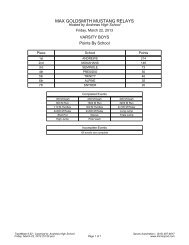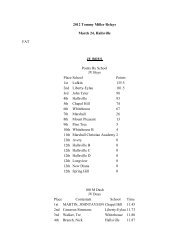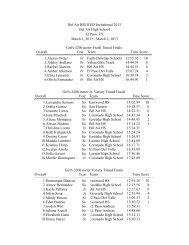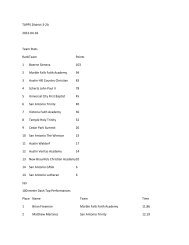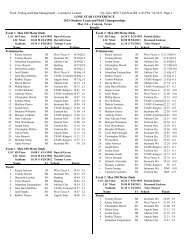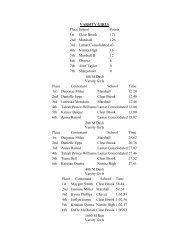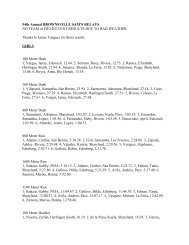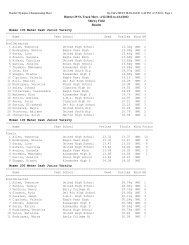1. PAGES 1-35 - Texas Track & Field Coaches Association
1. PAGES 1-35 - Texas Track & Field Coaches Association
1. PAGES 1-35 - Texas Track & Field Coaches Association
Create successful ePaper yourself
Turn your PDF publications into a flip-book with our unique Google optimized e-Paper software.
C OACHING YOUTHS<br />
Figure <strong>1.</strong><br />
Changes in form and proportion of the human body during fetal and postnal life. From Malina, R.M. (1984). Physical<br />
growth and maturation. In Motor Development during childhood and adolescence. Minneapolis, MN: Burgess.<br />
ing harder than adults’ hearts. For example, a six year-old<br />
boy has a resting heart rate of 86 beats per minute (a girl’s at<br />
the same age would be 88); by age 13, his resting heart rate<br />
would be 66 (hers would be 70). The maximum heart rate for<br />
a six year-old is 215, compared with 201 for a 13-year-old.<br />
Anaerobic power, the ability to work without oxygen, is<br />
also lower in children than in adults. This is because children<br />
have less of an important enzyme (phosphofructokinase<br />
or PFK) in their muscles; this enzyme allows the muscles<br />
to work without oxygen. Children produce more PFK<br />
after puberty. Anaerobic power is important in activities<br />
such as sprinting.<br />
Children also have a lower hemoglobin concentration in<br />
the blood than adults. Hemoglobin is the part of blood that<br />
carries oxygen to the working muscles (e.g., in the heart and<br />
legs), so children transport less oxygen per unit of blood<br />
than adults. This means that children can do less work than<br />
adults. Hemoglobin content in the blood increases at puberty;<br />
however, the increase is not as great in women as it is in<br />
men.<br />
Children become more fit as a result of fitness training but<br />
the responses to training tend to be lower in children than in<br />
adults for several reasons:<br />
Children tend to be more fit at the onset, so training<br />
results in less improvement<br />
Children have higher resting and maximum heart rates,<br />
which limits the intensity of training<br />
Children have less hemoglobin, which limits maximal oxygen<br />
uptake.<br />
During exercise, adults are working at closer to their maximum<br />
capacity (aerobic capacity) for oxygen delivery than<br />
during rest. Children work close to the maximum aerobic<br />
capacity all of the time, so they benefit less from cardiovascular<br />
training and they fatigue more rapidly during exercise<br />
(Bar-Or, 1983). Much of the improvement is attributable to<br />
improved technique, for example pacing themselves when<br />
they are running a mile.<br />
Exercise training does produce three benefits for children<br />
and adults. First, hearts become stronger as a result of training<br />
as stroke volume (the amount of blood the heart can<br />
pump in one beat) increases. Second, more capillaries<br />
develop as a result of training, which provides a better supply<br />
of blood to the heart and working muscles. Third, better<br />
extraction of oxygen from blood leads to improved enzymatic<br />
reactions.<br />
Weight training for children is a controversial topic. The<br />
two most important issues are cost-benefit trade-off and<br />
potential for injuries. Weight training takes a lot of time and,<br />
for prepubescent children, the gains are small (Faigenbaum,<br />
Westcott, Loud, and Long (1999). Therefore, the time might<br />
better spend doing something else. As children are growing,<br />
there is risk of injury; however, low-intensity (low-weight)<br />
training regimens can be safe when the coach is qualified to<br />
coach young children.<br />
Children are not miniature adults—if they were, imagine<br />
how much easier coaching children would be! As people get<br />
older, they get better. Childhood lasts for about 12 years and<br />
is followed by adolescence, which continues for several more<br />
18 techniques AUGUST 2011



